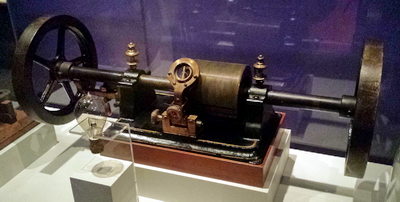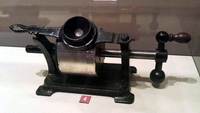|
Phonographs on Display at the Smithsonianís American History Museum
by Mark Caruana-Dingli

|
|
"Bergmann" tinfoil phonograph
|
|
|
While at the Smithsonianís American
History Museum, I also took some time
to locate other phonograph-related items
on display. I was pleased to find that there were
a few rare artefacts that hint at the museumís
formidable collection.
I was most impressed with the "Bergmann"
tinfoil phonograph that I located in an
"Innovations" display. These tinfoil phonographs
were manufactured for the Edison Speaking
Phonograph Company in 1878 by Sigmund
Bergmann in New York and a little research
indicated that the museum has two machines by
Bergmann, with the phonograph on display being
one of the three known early-style machines
in existence (referred to as the Experimental
Exhibition "Bergmann" phonograph). The one on
display was donated to the museum by Edisonís
associate William Hammer.

|
|
Edison Talking Doll
|
|
|
As for the other two
known Experimental Exhibition "Bergmann"
phonographs, one was given to Henry Ford by
Thomas Edison in 1929 while the other resides
at the Edison National Historic Site in West
Orange N.J.
All three machines have subtle
differences but can be distinguished from the
later Exhibition Phonographs made by Sigmund
Bergmann as they have double flywheels and
somewhat more elaborate decorations.
The other
tinfoil phonograph in the museumís collection
(but not on display) is the similar but later
Edison Exhibition Phonograph, also by Sigmund
Bergmann, which was donated to the museum by
Thomas Edison in 1929.

|
|
Edison Parlor Phonograph
by Brehmer Brothers
|
|
|
Another tinfoil phonograph on display was the
Edison Parlor model by Brehmer Brothers (it
appears that the Smithsonian collection includes
4 of this version of the Parlor Phonograph). This
small machine was intended to be marketed to
the public but disappointing sales resulted in only
small numbers of these being produced, with
possibly less than 20 known to have survived.
In another area of the museum, I located an
Edison Talking Doll which was a dismal
marketing failure when introduced to the public
in 1890. In spite of the significant problems and
its costly failure for Edison and his investor,
this product does mark a milestone as it was
the first recorded audio product sold for home
entertainment.
The doll, which stands 22 inches
high and weighs 4 pounds, was originally sold
for $10 with simple chemise or $20-$25 with
full dress. The phonograph located inside the
dollís chest was not spring-driven but played by
turning a crank at a steady speed.
The failure
of this venture can be attributed to the fragility
of the wax records and of the mechanism, with
the steel needle causing the cylinder records to
rapidly wear. After numerous returns, production
was ceased and the remaining dolls were sold off
without the motors.
Unfortunately, the one machine that I was not
able to locate was Emile Berlinerís original
gramophone, which probably resides somewhere
in the museumís storage but is not presently on
display.
|